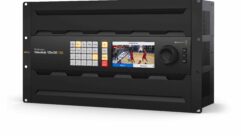The Digital Video Future
May 1, 2001 12:00 PM,
David Parish
Although DVD players are true digital playback devices, they really only deliver on one of the three promises of digital media.
The distinction between player and server eventually fades.
TAKE A MOMENT TO CLEAR YOUR MIND. I’m going to give you a phrase, and I want you to notice what images, ideas and associations come to mind. The phrase is video source.
What were your first ideas? Not long ago, terms like video source or video player would have unanimously led to thoughts of VCRs and laserdisc players. Nowadays, chances are pretty good the associations are of DVD players, because now when you need to provide video playback for a commercial application, you turn to an industrial DVD player by default.
Whether you consciously decided to upgrade your technology or were just going with the flow of innovation, you and your company have probably made the transition from analog to digital video. It’s a sneaky sort of transition though, because although DVD players are true digital playback devices, they really only deliver on one out of the three promises of digital media: that of high video quality at a relatively low cost. Industrial DVD players do such a good job of mimicking the functionality of legacy technology — namely laserdisc players — while improving quality, that from an implementation perspective, the transition to digital is often seamless.
On the one hand, this in itself is an impressive feat. On the other hand, this seamlesness is achieved in large part by sacrificing the other two promises of digital media: content transportability and precise content control.
While it is true that a large percentage of video applications are well satisfied by the capabilities of industrial DVD players, an argument can be made that video, in general, and digital video, in particular, are on the way to becoming mainstream communication elements that will eventually be thought of similarly to PowerPoint presentations, Web pages, Adobe Acrobat files and MS Word documents.
The quality of video in this context must be at or beyond standard definition broadcast quality. A streaming video Web experience won’t do. The migration of digital video into mainstream applications can only occur, however, when digital video players incorporate all three of the value propositions associated with it. The implication is that while DVD players will be an important element as this transition evolves, they will not drive the transition. That job will be left to an emerging generation of digital video players that incorporate both disk-based and streaming playback capabilities. Accordingly, the references made in this discussion to digital video players are not references to DVD players.
THE PROMISES OF DIGITAL VIDEO
For digital video to enter mainstream markets, it will need to fully realize its three fundamental advantages over legacy video-playback technologies. The first advantage is cost versus quality. With proper encoding, a process that’s getting easier and cheaper every year, high-bit-rate MPEG-2 files look great. But by itself this probably isn’t as important as it sounds. It certainly doesn’t represent enough of a value proposition to make an entire industry change the way it works. The fact is that the video quality of prior technologies (including commercial DVD) has been adequate, at a competitive cost. The real value of going digital emerges in the context of content updating and playback control.
Content Immediacy
In the digital domain, changing video content should be as easy as replacing one file with another — a process that has become second nature to a demographic that has gotten used to wearing Palm Pilots on their belts. Even more importantly, as bandwidth becomes adequate, changing content can, and eventually will, happen remotely. Data is already being moved from remote to local locations, an event fundamentally equivalent to what happens every time you go on the Internet.
The technical implication of remote content updating is that the video player must have either a writable local storage capability for “store-and-forward” playback, and/or be capable of decoding the incoming data instantly upon its arrival, for “streaming” playback. An ability to change video content effortlessly and remotely is precisely the type of value proposition that can drive discontinuous innovations into mainstream markets. This new feature of digital video can change the way markets think about how (as well as where, when and why) video can be used.
Think about the impact of this easy remote control on a visual merchandising application. With remote content updating, a merchandising manager who has access to a network of in-store digital signage can change the merchandising message based upon a relevant event, such as a change in weather or inventory, from anywhere. The technology creates opportunities to “micro-merchandise” that until now have not been part of the retail merchandising world.
The assumption, of course, is that micro-merchandising creates fundamental value to the retailer by increasing sales and margins and/or improving inventory turns. This is an example of how discontinuous innovations move into mainstream applications by creating tangible value where none existed before. That is, how can traditional in-store signage do this? It can’t.
Control Immediacy
This third value proposition is somewhat subjective. Laserdisc players provide frame-accurate control, as do DVD players, though with DVD the definition of frame changes. Moving from these formats to disk-based store-and-forward and streaming video players provides multiple opportunities for control that are simply unavailable within legacy playback technologies. For example, disk-based video players allow multichannel playback, leading to multichannel frame-accurate control. Further, this class of video players (I’m trying very hard to not use the term server) often provides an ability to create playback scripts that allow for precise playback date and time control — even across multiple channels.
Given remote updating, it becomes possible to change and control the playback script itself, independent of changes to the content. Control may also refer to onscreen graphic displays, multiple audio tracks and video output formats, all of which are tightly integrated into the digital video file definition.
In ways that are similar to remote updating, this explosion in control parameters changes the perception of where and how video fits into business applications. In a general sense, content immediacy means I can change my content any time I want to; and control immediacy means that once I have the content I need, I can manipulate it in a wide variety of ways. These two attributes collectively represent the virtual backstage pass that allows video to become a mainstream communication medium in the world of business — right along side the Web and Microsoft Word files.
Think about it. How are people most effectively entertained, informed, influenced and taught? By watching and listening. If a technology came along that allowed you to micromanage your content to most directly entertain, inform, influence and teach at each moment, you would want to use it. This technology is here today, poised on the brink of the mainstream.
PLEASE DON’T CALL IT A SERVER!
Even if you believe that digital video provides the basis for a fundamental shift in the way video is used, the path to that goal is affected by a large number of factors, only a few of which can be influenced by manufacturers of digital video players. Bandwidth and component costs are, of course, central to the discussion. Still, the opportunity for digital video to flourish in existing commercial video applications such as retail, location-based entertainment, exhibitions, trade shows and digital signage, is based primarily on the features and costs of the video players themselves.
According to Chasm Theory (see Sidebar on page 28), early products represent generic products whereas mainstream markets demand whole products.
In the world of digital video playback, the generic product standard is the industrial DVD player. The key for digital video to successfully move from generic product to whole product is to retain the benefits (familiarity, ease-of-use and reliability) of industrial DVD players while adding value propositions, such as content immediacy and control immediacy. Table 1 summarizes those features of DVD which are generic and those which, by extending functionality beyond that of a standard DVD player, move into the realm of a whole product (in red).
Note that whole products leverage and build upon existing features in the generic model. For example, existing knowledge about industrial DVD players gets leveraged in such a way that no new training is required, save that directly related to new functionality (such as remote content updating and greater control options). Similarly, installation and debugging and systems integration are handled just as they would be for a DVD player (and/or for multiple DVD players, since multichannel support is available), thus achieving efficiencies.
The irony is that, despite their differences, as long as the design and implementation are done well, users of whole products (whether the VAR, contractor, A/V design consultant or end-user) will not make much distinction between them and their generic forebears. In this way, the distinction between player and server eventually becomes unimportant. And this in turn will set the stage for the introduction of a true digital video player into mainstream commercial use.
GET READY TO RUMBLE
This phenomenon applies across all digital video technologies. Taking a look at the landscape of products now available, you will see a noticeable shift in the types of products appearing and how they’re being positioned and marketed by their manufacturers.
On the encoding side, companies like Optibase, Vbrick and Minerva have put their network-attached video appliances into the mix. On the playback side is the Firefly™ from Visual Circuits among others. Display manufactures refer specifically to digital signage applications as they pursue opportunities to move their products out of the smaller niche markets and into much larger mainstream markets.
Even more to the point, all of these products go to great lengths to insulate the user from the technical complexity previously associated with dig-ital video. Network-attached encoders are essentially “plug and play,” with only modest networking skills required by the installer or user. Displays are now often multi-standard, accepting a variety of inputs, from VGA to RGB to HD.
The shift of digital video to mainstream markets is also showing up in what customers are asking for and how they’re asking. One of the surest signs of the impending move into mainstream markets is the fact that users no longer seem to believe that digital video provides them with a competitive advantage. Rather, they believe it is simply the best solution to a business problem or opportunity they have to address. In that context, one of the most important factors considered by a mainstream decision-maker is choosing products from companies that are industry leaders and are likely to continue to be leaders. Moreover, they want to choose products from the same companies their peers are selecting.
It’s dark and dangerous in the chasm, and you can’t really know how long your product might remain there. But when at last the mainstream markets move to incorporate digital video as a key element in their infrastructure, the scope of opportunity for the companies prepared to deal with this move will be virtually unlimited. Good luck and remember: don’t look down.
David Parish is CEO of Visual Circuits, based in Minneapolis, Minnesota. Visual Circuits designs and builds hardware/software solutions for content distribution and digital media playback.
Applying Chasm Theory to Digital Video: Now Entering the Chasm
DIGITAL VIDEO REPRESENTS WHAT IS CALLED A “DISCONTINUOUS INNOVATION” in the commercial video industry. It requires users to fundamentally change the way they think about video, the skills required to successfully sell, implement and support video, and the types of applications that can and will use video.
By contrast, the industrial DVD player is a “continuous innovation.” It delivers incremental improvements over existing technology, without requiring a fundamental shift in activity or perception by either the contractor or the end user.
The notion of discontinuous and continuous innovations represents the jumping-off point for a very influential discussion of how high-tech products emerge in early and mainstream markets, undertaken by Geoffrey Moore in the seminal book on this topic, Crossing The Chasm (HarperBusiness, 1991).
In simple terms, Chasm Theory suggests that the acceptance of discontinuous innovations travels through a fairly well defined technology-adoption lifecycle (See Figure 1). Through the course of that lifecycle, products are sold in chronological order first to innovators and then early adopters. These are the people who are willing to put up with the shortcomings of new technology because they love to tinker with it, and because they believe they can gain a competitive advantage by putting the new technology to use. And, indeed, they sometimes do.
Eventually, the product is sold to the early majority, then the late majority, which together comprise the mainstream markets. In the long run, discontinuous innovations must make it into mainstream markets. This is the chasm, and it is here that most high-tech companies and products crash without recovery. The chasm sits between the early and mainstream markets and represents the profound differences in buying habits and product and business requirements between these two markets. High-tech products and companies that do very well in early markets, even though these can be quite large, will have little chance of success in mainstream markets without significant changes to the products and the company.
Crossing The Chasm is a must-read because digital video has recently entered the chasm. Early adopters and innovators in the commercial A/V world have spent the past few years tinkering, experimenting with and deploying various forms of digital video players and related devices. Products from companies like Visual Circuits, Optibase, Optivision, Minerva, Vbrick, Alcorn McBride and others have been floating around the periphery of the core commercial A/V business, but none have really entered the market in a dominant way. (As a continuous innovation, DVD didn’t have to jump the chasm.) However, when digital video emerges into mainstream markets — and when is the key word here — watch out because another tenet of Chasm Theory is that when mainstream markets adopt a new technology, the entire market moves simultaneously, creating tremendous upheaval and opportunity.
Additional software
- Transport control
- LD command set (RS-232)
- IR remote control interface
- Playback scheduling
- Performance reporting
- Web interface
- Remote monitor and control
- FTP client/host
Additional hardware
- Balanced audio option
- Show control interface
- IR remote control
- Encoding system
- Broadband support
- Multichannel support
System integration
- A/V industry contractors
Installation & debugging
- A/V industry contractors
Cables & accesories
- A/V cables
- Network cables
- Swappable hard drive
Training & support:
- Manufacturer’s reps
- Depot repair
- Telephone support
- Swap program
Standards & procedures
- MPEG-2
- DVD user interface
- Web style user interface
- TCP/IP networking
TABLE 1: Features of generic (black only) and whole-product model video players (red).










